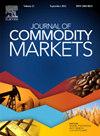Examining perceived spillovers among climate risk, fossil fuel, renewable energy, and carbon markets: A higher-order moment and quantile analysis
IF 4.5
4区 经济学
Q1 BUSINESS, FINANCE
引用次数: 0
Abstract
The complex risks of global climate change and the transition to a sustainable economy have increasingly become central to research and policy debates. Climate risk perceptions influence fossil fuel, renewable energy, and carbon markets through both investment behavior and regulatory policy channels. Understanding the spillovers between climate risk perceptions and commodity markets has profound implications for sustainable investments and risk management strategies. This paper extends the existing literature by examining higher-order moment risk spillovers among perceptions of climate physical risks (CPR) and transition risks (CTR), fossil fuel, renewable energy, and carbon markets across different quantiles. Furthermore, this paper also proposes an analytical framework that integrates ex-post moment measures with an innovative QVAR extended joint connectedness approach. Our empirical analysis reveals that the connectedness outcomes are contingent upon moment orders and specific quantile levels. Notably, total spillovers are markedly higher at the extreme quantiles (especially at the 0.95 quantile) compared to the median quantile. Importantly, CPRI and CTRI serve as net transmitters of spillovers at the 0.05 and 0.95 quantiles but shift to being net recipients under normal market conditions. The directional net spillovers transmitted from climate risk perceptions to energy and carbon markets are more pronounced and consistent at the extreme higher and lower quantiles. Finally, we find that dynamic total spillovers of skewness and kurtosis at extreme quantiles are more volatile than at the median, with significant sensitivity to major events such as the COVID-19 pandemic, the Russia-Ukraine war, the Israel-Hamas war, extreme climate disasters, and the United Nations Climate Change Conferences.
考察气候风险、化石燃料、可再生能源和碳市场之间的感知溢出效应:高阶矩和分位数分析
全球气候变化和向可持续经济转型的复杂风险日益成为研究和政策辩论的核心。气候风险认知通过投资行为和监管政策渠道影响化石燃料、可再生能源和碳市场。了解气候风险认知与大宗商品市场之间的溢出效应对可持续投资和风险管理战略具有深远影响。本文通过研究气候物理风险(CPR)和转型风险(CTR)、化石燃料、可再生能源和碳市场感知之间的高阶矩风险溢出效应,扩展了现有文献。此外,本文还提出了一个将事后矩测度与创新的QVAR扩展联合连通性方法相结合的分析框架。我们的实证分析表明,连通性的结果取决于时刻顺序和具体的分位数水平。值得注意的是,与中位数相比,极端分位数(尤其是0.95分位数)的总溢出效应明显更高。重要的是,CPRI和CTRI在0.05和0.95分位数处是溢出效应的净发送者,但在正常市场条件下转变为净接收者。气候风险感知向能源和碳市场传递的定向净溢出效应在极端高分位数和低分位数上更为明显和一致。最后,我们发现偏度和峰度在极端分位数处的动态总溢出比在中位数处更不稳定,对COVID-19大流行、俄罗斯-乌克兰战争、以色列-哈马斯战争、极端气候灾害和联合国气候变化会议等重大事件具有显著敏感性。
本文章由计算机程序翻译,如有差异,请以英文原文为准。
求助全文
约1分钟内获得全文
求助全文
来源期刊

Journal of Commodity Markets
Multiple-
CiteScore
5.70
自引率
2.40%
发文量
53
期刊介绍:
The purpose of the journal is also to stimulate international dialog among academics, industry participants, traders, investors, and policymakers with mutual interests in commodity markets. The mandate for the journal is to present ongoing work within commodity economics and finance. Topics can be related to financialization of commodity markets; pricing, hedging, and risk analysis of commodity derivatives; risk premia in commodity markets; real option analysis for commodity project investment and production; portfolio allocation including commodities; forecasting in commodity markets; corporate finance for commodity-exposed corporations; econometric/statistical analysis of commodity markets; organization of commodity markets; regulation of commodity markets; local and global commodity trading; and commodity supply chains. Commodity markets in this context are energy markets (including renewables), metal markets, mineral markets, agricultural markets, livestock and fish markets, markets for weather derivatives, emission markets, shipping markets, water, and related markets. This interdisciplinary and trans-disciplinary journal will cover all commodity markets and is thus relevant for a broad audience. Commodity markets are not only of academic interest but also highly relevant for many practitioners, including asset managers, industrial managers, investment bankers, risk managers, and also policymakers in governments, central banks, and supranational institutions.
 求助内容:
求助内容: 应助结果提醒方式:
应助结果提醒方式:


